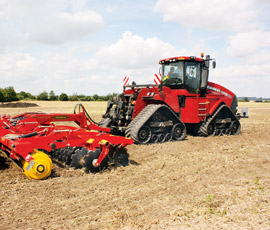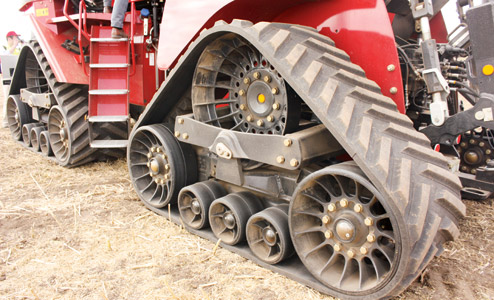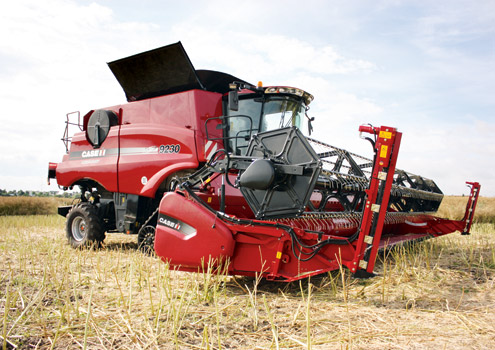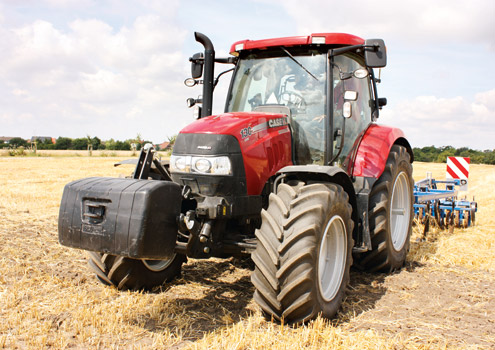Case Quadtrac gets extra horsepower

You may have thought it couldn’t possibly get any more powerful, but Case IH has given its tracked Quadtrac another injection of horsepower.
The previous flagship was the 600 Quadtrac, which topped the UK power league with a meaty 670hp. Now the company has added three new models – the Quadtrac 540 with 540hp, the 580 with 580hp and the top of the range Quadtrac 620 with rated power of 628hp and max power output of 692hp.
It also means the Quadtrac retains the title of the most powerful production tractor in the world.
Power comes from a six-cylinder engine from FPT Industrial, a separate arm of the Case New Holland empire. It’s the same 12,900cc unit as before but now with two intercoolers and heavyweight torque of 2,941Nm. Fuel tank capacity is a massive 1,900 litres (which, incidentally, will cost you £1,330 to fill up), plus a 300 litre AdBlue tank.
The Quadtrac is also one of the first Case IH models to use an SCR-only engine to meet the latest Tier 4 Final emissions regs.
Though the all-up weight of the Quadtrac is a not-inconsiderable 26t, the four tracks give a big footprint of 5.6sq m. That’s some 25% greater than any other tracked machine, claims the company, and also makes for almost zero slip.
 The tracks can pivot up and down by 10deg to maintain good soil-to-rubber contact. Each is independent of its neighbour and the long wheelbase of 3.92m is said to help get the power from engine to soil without drama.
The tracks can pivot up and down by 10deg to maintain good soil-to-rubber contact. Each is independent of its neighbour and the long wheelbase of 3.92m is said to help get the power from engine to soil without drama.
A full powershift gives 16 forward speeds and two reverse ones and max speed is 37kph. Nine gears cover typical fieldwork tasks and the Class 5 drawbar can cope with vertical forces up to 7t. Rear linkage, capable of lifting 9t, is an option and you can even fit a rear 1,000rpm pto.
However, when fitted with 710mm tracks (910mm ones are an option, too) the overall width of the tractor comes out at a surprisingly modest 2.99m.
What’s it like to drive? You sit in a big cab, high up from the ground like the captain of a big ship, so there’s a nice feeling of detachment from the hard work going on below deck. The latest version of the cab even has a ventilated seat to keep things fresh.
Keen usersThe UK has been one of the biggest markets for Quadtracs ever since the first model was launched in 1997, says UK product marketing specialist Paul Freeman. Most are bought by big farms and estates but several have joined contractors’ businesses. Apart from the acre-gobbling throughputs, one of the appeals is that they need no ballasting.
Czech Republic, German and Polish farmers are also keen users of Quadtracs. However, in other parts of eastern Europe farmers like to dual their tractors up with big wheels and have fewer road regs to contend with. In France, bizarrely, the government puts a 500hp limit on imported tractors.
 The tracked tractor market in the UK is pretty select and primarily involves big farms who need unstoppable traction. The other contenders in the track stakes are Deere with models from 341 to 616hp and Agco’s Challenger with models from 335hp to 382hp.
The tracked tractor market in the UK is pretty select and primarily involves big farms who need unstoppable traction. The other contenders in the track stakes are Deere with models from 341 to 616hp and Agco’s Challenger with models from 335hp to 382hp.
The first public showing of the latest Quadtracs will be at the Agritechnica show in Hanover in November. Prices have yet to be published.
Want more hp?
At nearly 700hp, is the latest Quadtrac reaching the limits of tractor horsepower? Yes and no, says in-house engine maker FPT. The main problem is getting rid of heat, an inevitable by-product of friction in an engine.
The same six-cylinder engine in New Holland’s FR850 forage harvester puts out 850hp, but needs a massive radiator to get rid of the heat. Luckily it has the space to accommodate that. Tractor makers, however, struggle to squeeze their existing engines and cooling packages under the bonnet, let alone find room for yet more radiators.
The same engine, incidentally, pushes out 1,000hp when it’s powering a leisure boat. But that sort of craft rarely does more than 200 hours a year, says FPT, so the strain on the engine is lower.
Combines
Case IH announced changes to its 2014 Axial Flow combines back in April and showed them off at Cereals. However, this was the first time we had seen the latest machines in the field.
The most exciting thing for farmers wanting to get maximum throughput in these catchy harvests is the availability of a 12.2m (40ft) header, something of a jump from the current top-of-the-range 10.7m (35ft) one.
It’s a true 12.5m (41ft) cut, which should appeal to farmers trying their hand at Controlled Traffic Farming. One unit is already on trial in the UK this summer.

There was also news that Case IH will offer its own draper header for the 2014 harvest as well as the familiar Canadian-made draper header imported to the UK by Shelbourne Reynolds.
That’s mainly of interest to US and Australian farmers, but half a dozen McDon units are currently working in the UK and the technique is gathering pace. The main advantages are speed of crop flow to the feeder housing and more scope to change the angle of the header to cope with different crop conditions.
As with other combine makers, Case IH UK reports a steady move from tyres to tracks among buyers of bigger models. In the 2012 harvest it had just five tracked units out, three of them on demo; this year some 23 tracked combines have gone out.
And while it’s improved traction (especially in wet weather) that’s primarily making farmers flock to tracks, the reduction in swaying makes the driver’s life more pleasant, too, says Case IH’s European harvesting co-ordinator Paul Harrison. There will also be a suspended track version, designed primarily improve the ride on the road, on show at this November’s Agritechnica show.
Case IH models for 2014 will also get the firm’s chop-to-swath system. This allows the driver to move from swathing the straw to chopping it by pressing a button. The whole process takes less than a minute and will be good news for farmers who like to chop on the headland and swath the land.
Unloading auger optionsCase IH will offer two auger options for 2014, an 8.8m unit and a 10.4m one. The first of these folds to 95deg, while the second (for headers of more than 12m) folds to 135deg.
An electrically-operated pivoting-spout option allows the operator to alter the flow of grain in or out from the multifunction lever while emptying on the move. That should mean less frantic repositioning by the trailer driver.
Meanwhile powered grain tank covers make life easier for the operator at the beginning or end of the working day (or when going on the road).
Maxxum CVXWill all tractors have CVT gearboxes in the next few years? Case IH’s product marketing specialist Paul Freeman reckon that’s a distinct possibility and the company is putting its money where its mouth is by offering Maxxum CVX tractors down to 110hp.

Available in January 2014, the CVX 110, 120 and 130 are powered by FPT 4.5 litre engines and gain 22hp in boost mode. Meanwhile, a 40kph Eco Speed cuts revs to just 1,600rpm at 40kph while 50kph Eco Speed chops revs back to a measly 1,750rpm.
There’s also an interesting idle speed control to cut fuel use. If you leave the cab with the engine running at idle for more than 30 seconds, the tractor will automatically cut engine revs from 850rpm to just 650rpm, provided neither the hitch nor the remote switches are operating.

